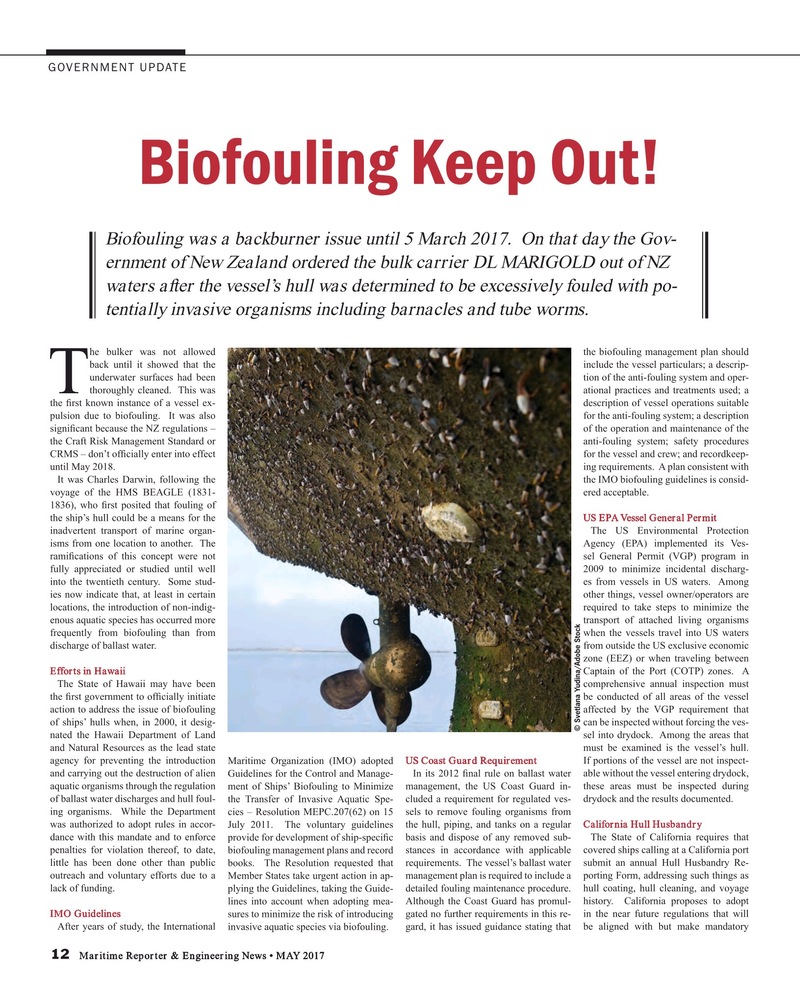
Page 12: of Maritime Reporter Magazine (May 2017)
The Marine Propulsion Edition
Read this page in Pdf, Flash or Html5 edition of May 2017 Maritime Reporter Magazine
GOVERNMENT UPDATE
Biofouling Keep Out!
Biofouling was a backburner issue until 5 March 2017. On that day the Gov- ernment of New Zealand ordered the bulk carrier DL MARIGOLD out of NZ waters after the vessel’s hull was determined to be excessively fouled with po- tentially invasive organisms including barnacles and tube worms. he bulker was not allowed the biofouling management plan should back until it showed that the include the vessel particulars; a descrip- underwater surfaces had been tion of the anti-fouling system and oper-
Tthoroughly cleaned. This was ational practices and treatments used; a the ? rst known instance of a vessel ex- description of vessel operations suitable pulsion due to biofouling. It was also for the anti-fouling system; a description signi? cant because the NZ regulations – of the operation and maintenance of the the Craft Risk Management Standard or anti-fouling system; safety procedures
CRMS – don’t of? cially enter into effect for the vessel and crew; and recordkeep- until May 2018. ing requirements. A plan consistent with
It was Charles Darwin, following the the IMO biofouling guidelines is consid- voyage of the HMS BEAGLE (1831- ered acceptable.
1836), who ? rst posited that fouling of the ship’s hull could be a means for the US EPA Vessel General Permit inadvertent transport of marine organ- The US Environmental Protection isms from one location to another. The Agency (EPA) implemented its Ves- rami? cations of this concept were not sel General Permit (VGP) program in fully appreciated or studied until well 2009 to minimize incidental discharg- into the twentieth century. Some stud- es from vessels in US waters. Among ies now indicate that, at least in certain other things, vessel owner/operators are locations, the introduction of non-indig- required to take steps to minimize the enous aquatic species has occurred more transport of attached living organisms frequently from biofouling than from when the vessels travel into US waters discharge of ballast water. from outside the US exclusive economic zone (EEZ) or when traveling between
Efforts in Hawaii Captain of the Port (COTP) zones. A
The State of Hawaii may have been comprehensive annual inspection must the ? rst government to of? cially initiate be conducted of all areas of the vessel action to address the issue of biofouling affected by the VGP requirement that of ships’ hulls when, in 2000, it desig- can be inspected without forcing the ves- © Svetlana Yudina/Adobe Stock nated the Hawaii Department of Land sel into drydock. Among the areas that and Natural Resources as the lead state must be examined is the vessel’s hull. agency for preventing the introduction Maritime Organization (IMO) adopted US Coast Guard Requirement If portions of the vessel are not inspect- and carrying out the destruction of alien Guidelines for the Control and Manage- In its 2012 ? nal rule on ballast water able without the vessel entering drydock, aquatic organisms through the regulation ment of Ships’ Biofouling to Minimize management, the US Coast Guard in- these areas must be inspected during of ballast water discharges and hull foul- the Transfer of Invasive Aquatic Spe- cluded a requirement for regulated ves- drydock and the results documented. ing organisms. While the Department cies – Resolution MEPC.207(62) on 15 sels to remove fouling organisms from was authorized to adopt rules in accor- July 2011. The voluntary guidelines the hull, piping, and tanks on a regular California Hull Husbandry dance with this mandate and to enforce provide for development of ship-speci? c basis and dispose of any removed sub- The State of California requires that penalties for violation thereof, to date, biofouling management plans and record stances in accordance with applicable covered ships calling at a California port little has been done other than public books. The Resolution requested that requirements. The vessel’s ballast water submit an annual Hull Husbandry Re- outreach and voluntary efforts due to a Member States take urgent action in ap- management plan is required to include a porting Form, addressing such things as lack of funding. plying the Guidelines, taking the Guide- detailed fouling maintenance procedure. hull coating, hull cleaning, and voyage lines into account when adopting mea- Although the Coast Guard has promul- history. California proposes to adopt
IMO Guidelines sures to minimize the risk of introducing gated no further requirements in this re- in the near future regulations that will
After years of study, the International invasive aquatic species via biofouling. gard, it has issued guidance stating that be aligned with but make mandatory 12 Maritime Reporter & Engineering News • MAY 2017
MR #5 (10-17).indd 12 MR #5 (10-17).indd 12 5/3/2017 7:55:00 PM5/3/2017 7:55:00 PM

 11
11

 13
13
